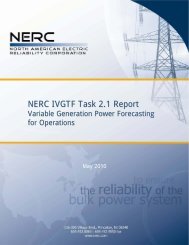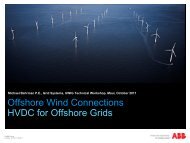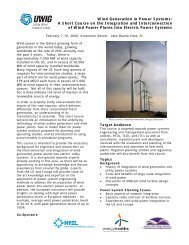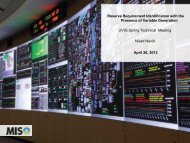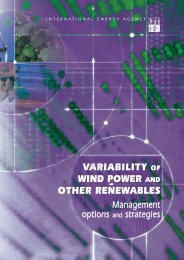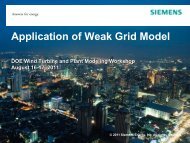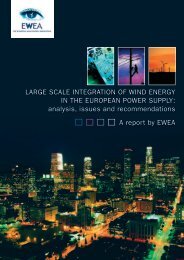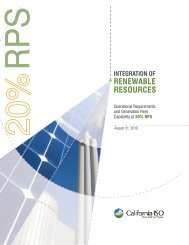Integrating Southwest Power Pool Wind to Southeast Electricity ...
Integrating Southwest Power Pool Wind to Southeast Electricity ...
Integrating Southwest Power Pool Wind to Southeast Electricity ...
You also want an ePaper? Increase the reach of your titles
YUMPU automatically turns print PDFs into web optimized ePapers that Google loves.
of the generation while being limited only by hurdle rates given that losses were removed in the<br />
previous step.<br />
Removing Losses small change in<br />
generation export & economic flows.<br />
Unconstraining Transmission big<br />
change in generation export<br />
Figure 2-1<br />
Comparison of Average Net Flow Out of Each Region for 7 and 14 GW Cases<br />
Conclusions<br />
In order <strong>to</strong> effectively investigate the scheduling/balancing challenges of utilizing SPP wind<br />
generation <strong>to</strong> meet a 20% RES across the SPP and SERC footprint and <strong>to</strong> evaluate the benefits of<br />
coordination between regions in meeting this challenge, the modeled transmission system would<br />
either have <strong>to</strong> be expanded or “unconstrained” <strong>to</strong> allow the new wind generation <strong>to</strong> be delivered.<br />
Developing a reasonable transmission expansion plan that was acceptable <strong>to</strong> all stakeholders was<br />
outside the scope of the project. Test cases simulated <strong>to</strong> better understand the impacts of<br />
removing transmission system losses and thermal constraints show that the primary impact is<br />
from removing the constraints. Since the study is not evaluating the capital costs of transmission<br />
that would be needed <strong>to</strong> support wind transfers from SPP <strong>to</strong> SERC, the gross “unconstrained”<br />
assumption is an approximation of the assumption that transmission will exist <strong>to</strong> support wind<br />
transfers in order for the wind <strong>to</strong> be developed for export. While certainly not a perfect<br />
assumption, the project team believes that it does allow for an assessment of the benefits of<br />
coordination for scheduling/balancing with some appropriate caveats.<br />
As such, all of the High <strong>Wind</strong> Transfer cases that are described in detail in the remainder of this<br />
report are simulated using the UPLAN Transportation mode solution method where losses and<br />
thermal constraints are not respected. As with all of the results of the project, the specific<br />
quantitative results obtained from these simulations are less important than the insights that are<br />
obtained by comparison between cases as specific scenario parameters are changed. Where<br />
appropriate in the presentation of results, it is noted how the “unconstrained” transmission<br />
2-4




